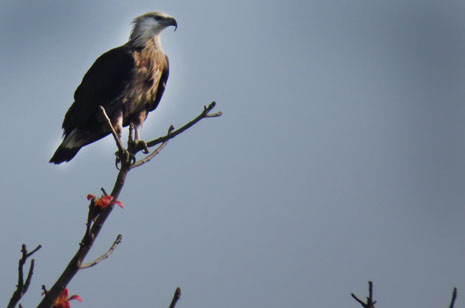
A rare Asian raptor continues to disappear, and a University of Arkansas scientist wants to find out why.
Marla Steele, a doctoral student in biological sciences, is one of a handful of people in the world who are studying the Pallas’s fish eagle, a large fishing eagle that is mainly dark brown, with a light brown to white head and neck that breeds in Central Asia.
The eagle is classified as “vulnerable,” by the International Union for Conservation of Nature. Less than 10,000 adults are known to exist.
It is the most poorly studied eagle in the northern hemisphere, she said.
“There have not been any detailed migration studies, there is almost nothing known about what their non-breeding habitat requirements are, and from what I have seen there hasn’t been a complete survey for that species conducted in the last 30 years,” she said.

Marla Steele holds a northern goshawk.
|
Steele hopes to fill those gaps with her fieldwork in India and Mongolia, which she will use for her dissertation in the department of biological sciences. She recently returned from a second trip to India where she studied the birds for a month, in addition to collecting fish on which the eagles feed. Local farmers may be polluting the wetlands with pesticides, causing a precipitous drop in the eagle’s population there, she said.
“We need to see what’s in the fish,” she said. “It’s a bioaccumulation. The eagle is an apex predator, so when the eagles die off that’s an indication that something is wrong.”
This summer, she will travel to Mongolia to continue her fieldwork and also to trap two Pallas’s fish eagles and attached electronic tracking units to them that will transmit data to Steele’s computer.
“The goal right now is to provide a baseline study, from which future researchers can take information,” she said. “We can’t work on conserving a species that we don’t know anything about right now. The bird used to be one of the most common raptors along waterways about 100 years ago. Their range extended from Russia to Myanmar, from the Caspian Sea to the middle of China. They’ve been extirpated in almost all those countries. We really don’t know what happened.”
Steele had been to India before to study the eagle, and she recalls clearly the moment she first set sight on it on a mountaintop on the outskirts of Jim Corbett National Park.
“I had never heard these birds’ call,” Steele said. “I had never seen them outside of pictures. The nest was so well concealed by the side of the river it took me a moment to find it. I hear this wonderful, obnoxious cry that sounds like a combination of creaky fishing tackle and a laughing seagull. There it is. I could see this Pallas’s fish eagle just gliding right over the river and coming straight to the nest.”
Steele came to the U of A in 2010 after earning a bachelor’s degree in natural resource ecology and management from Oklahoma State University. As an undergraduate, she presented a paper on Japanese raptor migration at the Asian Raptor Research and Conservation Network’s annual meeting in Ulaanbaatar, Mongolia. She came to the University of Arkansas to study under Douglas James, a University Professor of biological sciences and an expert in ornithology.
“I was looking for somebody who would be crazy enough to take on a graduate student who would come in and say, ‘I want to do this research and by the way, I want to do it on the other side of the world,’” Steele said. “It’s a pretty tall order. Dr. James has done extensive work in Nepal, Africa; you name it. And he’s had several students do work all over the world. The fact that he’s able to coordinate these students with such impressive projects that are so far-reaching, it made me want to join his lab.”
Steele created a crowd-sourcing website to get people to pitch in to fund her fieldwork, which features a short video she titled, Where in the World are Pallas’s Fish Eagles?
“The main point is to try to get people as excited about this project as I am,” she said. “Most of the time, people think that we are just going out in the middle of the woods and staring at birds. I wanted to show how really important and wonderful our work really is.”
Topics
Contacts
Marla Steele, doctoral student
biological sciences
479-575-3251, mls013@uark.edu
Chris Branam, research communications writer/editor
University Relations
479-575-4737,
cwbranam@uark.edu